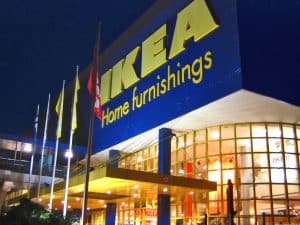The home furnishing giant has just created one of the most generous paid parental leave policies in the retail sector.
 We frequently hear how much better parental leave policies are in Europe, Canada, and…well just about everywhere in the world outside the U.S. But there are a growing number of bright spots for expecting parents here in the U.S., with Ikea now taking the lead. The furniture giant is rolling out a paid parental leave plan that looks to be the envy of workers in retail. According to Ikea president Lars Petersson, the underlying principle it is pretty simple.
We frequently hear how much better parental leave policies are in Europe, Canada, and…well just about everywhere in the world outside the U.S. But there are a growing number of bright spots for expecting parents here in the U.S., with Ikea now taking the lead. The furniture giant is rolling out a paid parental leave plan that looks to be the envy of workers in retail. According to Ikea president Lars Petersson, the underlying principle it is pretty simple.
“The home is our arena,” Petersson explained. “We think that it’s really important that people working for us get a chance to experience their home, especially when you’re welcoming a new family member.”
As of January 1, 2017, all Ikea workers in the U.S. ― from corporate executives to cashiers and salespeople in retail stores ― will be eligible for 3 months paid parental leave after working a full year at the company. They’ll collect full pay for the first 6 weeks, and then 50% of their regular pay for the second 6 weeks.
For those who’ve been with the company for three years or more, the deal is even more generous. Ikea will offer 4 months of paid leave, with the first 8 weeks covering full pay, and the second 8 at half pay. That comes in addition to any short-term disability leave the worker may be eligible for.
The upshot: when you factor in short-term disability, Ikea employees can to spend up to six months at home with their newborns, all without worrying about pay for the majority of it. Until now, workers were given merely a single week of paid leave as a supplement to short-term disability.
The company employs some 14,000 workers in the U.S. in all sorts of positions ― from driving trucks and working in its factory, to cash register jobs, call center agents and corporate employees .
Unlike workers in other developed nations, employees in the U.S. have no law guaranteeing at least some paid family leave. The Family and Medical Leave Act, which has existed since 1993, only guarantees 12 weeks of unpaid time off. Without federal regulation, offering paid leave is completely optional for U.S. businesses.
Granted, it has recently become more fashionable to offer paid leave, especially in the U.S. tech sector; yet American companies on the whole aren’t especially generous with the benefit. According to the Bureau of Labor Statistics, only 13% of U.S. workers in 2014 had access to paid time off when they became new parents, though that number has been growing in recent years. Those who get paid leave tend to be white-collar professionals; blue-collar or hourly employees are generally left to fend for themselves.
That situation puts the U.S. way behind places like Sweden, where Ikea was founded. There, paid vacation and family leave are embedded in both the culture and federal law. Petersson notes that he uses a full four weeks off in the summer ― “I take Swedish vacation; I work in America” ― and he doesn’t know many other U.S. executives who would do the same. He said Ikea wanted to make its paid leave program generous enough so that employees would actually use it.
“This is not so much to replicate anything we do in Europe,” Petersson said. “It’s just to take the values and culture … and transform that into the U.S. reality.
And in the same way that the program includes both blue- and white-collar employees, it also covers men and women, gay and straight employees alike. The leave offer is gender-neutral, so paternity leave is just as long as maternity leave, and employees who adopt or foster are guaranteed the same benefits as new biological parents. (However, unlike the FMLA, the Ikea program will only cover time off to care for a newborn child, not to tend to a sick family member.)
In addition to its generous parental benefits, Ikea is also piloting a sabbatical program. Employees who have seven years with the company care eligible for three unpaid months off for any reason they wish, with the employee’s position guaranteed when they return. For those who 11 years under their belt at the company, the sabbatical can be as long as six months, and for those with 15 years in, it can be an entire year.
Ikea has been boasting its reputation as a great employer over recent years. In 2014, the company raised its company-wide minimum wage, but it did so in a novel way. Rather than set a national minimum, it established its bottom wage on a store by store basis, linking each to the local living wage as calculated by the MIT living wage formula. It has raised those minimums twice since then.
Petersson reported that the living wage measures have worked out well so far, with the company coping with higher labor costs and employee turnover decreasing. He said he frankly doesn’t know what to expect from the new paid leave program. When he was working for Ikea in Japan, he said workers took greater advantage of their leave benefits than expected when the company introduced them there.
“We don’t really know how many people [in the U.S.] will take this,” Petersson said. “We are very curious what will happen.”




